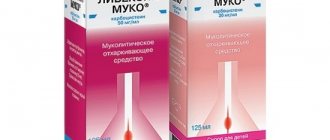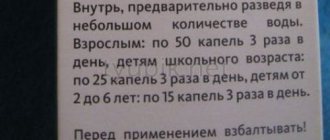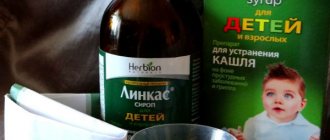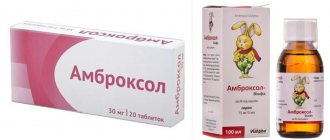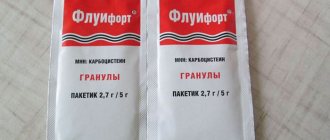Lazolvan syrup: release form, composition
The syrup is sold in bottles of 100 or 200 ml. It is packaged in a thin cardboard box, which includes instructions and a measuring cup for correct dosage determination. The solution itself has a viscous consistency and is sticky when hardened. It has no color and smells like berries. This is done to improve children's perception of the medicine.
The syrup tastes sweet, which is why it does not cause a negative reaction. The drug is also available in the form of lozenges, solution and tablets, but these are not suitable for children due to the form of application or composition. In some cases, this drug may be prescribed for inhalation for a young child. This is done to enhance the therapeutic effect and accelerate its onset.
"Lazolvan" syrup for children works due to the active substance in its composition - ambroxol hydrochloride. The medicine contains 15 mg. This concentration is enough to achieve a beneficial effect. Additional components ensure consistency of the composition and dosage form of the drug.
For this we use:
hydroxyethylcellulose (hyetellose);
acesulfame potassium; benzoic acid; glycerol; water; sorbitol; berry flavors. These substances do not have positive or negative effects on the patient's health, but give the medicine special properties that facilitate its use. These include release form, taste, smell and consistency. All this allows you to use “Lazolvan” for the comfortable treatment of children’s cough.
Lazolvan syrup
The syrup consists of an active ingredient - ambroxol hydrochloride, as well as a number of components that serve to create consistency, impart a pleasant taste and aroma. The syrup has a thick consistency, almost colorless, with a pleasant berry taste. It is sold in 100 ml dark amber glass bottles and contains 15 milligrams of ambroxol hydrochloride in 5 ml of syrup for children and 30 milligrams of the active substance in 5 ml of syrup for adults. Syrup of 15 milligrams in 5 ml is used in adults and children over twelve years of age - 10 milliliters, which is two teaspoons three times a day, and for children from six to twelve years old - 5 milliliters, which corresponds to one teaspoon two to three once a day. And for children from two to six years old - 2.5 milliliters, which corresponds to half a teaspoon three times a day, and children under two years of age are prescribed half a teaspoon twice a day, which is 2.5 milliliters.
Lazolvan syrup, which contains 30 milligrams of the active substance in 5 ml, is used only in adults and children over six years of age in dosages: adults and children over twelve years of age - 5 ml, which is one teaspoon three times a day. And for children from six to twelve years old - 2.5 ml, which corresponds to half a teaspoon two to three times a day.
Pharmacological properties and indications for use
The active substance of the drug, ambroxol, refers to compounds that stimulate the activity of the epithelium of the respiratory tract. This increases the synthesis of secretions, which ensures the removal of bacterial or viral agents from the bronchi. The drug also triggers the formation of lung surfactant, which allows the child to recover without the risk of residual effects.
Due to the active secretion of infectious agents with the resulting mucus, the disease progresses more easily and ends faster. This helps avoid prescribing additional strong drugs, such as antibiotics, to relieve the condition. At the same time, the feeling of irritation in the bronchi disappears, the frequency of coughing attacks and their intensity decreases.
"Lazolvan" syrup for children is prescribed for diseases of the respiratory system, which include:
chronic or acute bronchitis;
pneumonia (pneumonia) of any etiology; bronchial asthma; respiratory distress syndrome in newborns and elimination of its consequences; bronchiectasis. The drug is also prescribed for chronic and acute bronchial obstruction to alleviate the patient's condition.
At what age can it be given to children?
Cough syrup "Lazolvan" is prescribed from birth. To reduce the concentration, it is diluted in liquid and given as a drink.
The convenient dosage form allows children to easily swallow the product without the risk of choking or choking, as can be the case with hard tablets or dragees.
The drug can be taken by infants in the dosage prescribed by a pediatrician. Its use is indicated when the benefits of the medicine outweigh the risk of possible side effects.
Release form and composition of the drug
The main active ingredient of the drug "Lazolvan" for children is ambroxol hydrochloride. It is included in all dosage forms of the drug. In addition, the tablets contain magnesium stearate, colloidal silicon, lactose and corn starch. The composition of the Lazolvan dosage form for children in the form of syrup includes raspberry flavor, purified water, propylene glycol, benzoic acid, glycerol, sorbitol and tartaric acid.
The syrup has a pleasant raspberry aroma and a sweetish taste; it is colorless. The drug does not have a pronounced smell or taste, so it can be used to treat cough in children unnoticed (if the child does not like medications). Lazolvan tablets are round in shape, white or slightly yellowish in color. There is a mark on one side of the tablet to make it easier to break the tablet in half.
The drug "Lazolvan" in the form of syrup and solution is packaged in dark-colored 100 ml bottles, which are placed together with instructions and a measuring cup in a cardboard box. Lazolvan tablets for children are packaged in blisters of 10 pieces, which, like the syrup, are placed in cardboard packages - 2 or 5 each.
What kind of cough should you take syrup for: dry or wet?
To understand what kind of cough Lazolvan helps with, you need to remember its properties. If there is a large amount of sputum, syrup will aggravate the situation by adding more secretion. At the same time, the frequency of attacks will increase, and the person will get tired of the constant tickle.
Therefore, the medicine is prescribed for a dry cough or in the presence of thick and viscous sputum, which does not leave, but is felt in the bronchi. The drug liquefies it with fresh secretions and helps remove it from the lungs. This alleviates the patient's condition and speeds up recovery.
Instructions for use of "Lazolvan" for children
The instructions are printed inside a cardboard box with a bottle of the drug. It is also available directly on the packaging in an abbreviated version.
In some cases, it is possible to deviate from the recommended volume of the product at one time and prescribe an individual dosage and application regimen.
Dosage for children
The amount of the drug allowed per dose and per day depends on the age of the child.
How to take Lazolvan for newborns is decided on an individual basis. Up to 2 years of age, the recommended dose of the drug is 1 ml twice a day. Children aged 2-6 years drink 1 ml of syrup three times a day. A child 6-12 years old is advised to take 2 ml two to three times a day. Upon reaching the age of 12, the dosage sizes correspond to adults - 4 ml three times a day.
Compliance with the recommended standards will help avoid possible side effects, as well as complications from overdose.
How to take syrup: before or after meals?
The use of Lazolvan and its effectiveness are not associated with food intake. For young children, the medicine is given with food, drink or breast milk. This helps to better absorb the substances in the drug and also makes it easier to swallow. An older child can independently control when to use the medicine. Let it be a comfortable time for him, during which he will definitely not forget about the procedure.
LAZOLVAN 7.5MG/ML. 100ML. No. 1 R-R D/ORAL AND ING. FL./CAP. /BERINGER/
Cost in pharmacies: Biomedservice on the street. Kuibysheva, 62, tel. 56-94-88, 56-94-85, 8-913-685-12-21 390 rub. Biomedservice on Mira Avenue, 22, tel. 60-71-89, 60-62-73, cell. 8 983-526-39-96 393 rub. Biomedservice st. Dekabristov, 45., 533-573, 8-913-649-42-83, 420 rub. Biomedservice on the street. Ivana Alekseeva, 6, tel. 243-109, cell. 8-913-632-69-45 415 rub. Biomedservice on the street. 70 let Oktyabrya, no. 14, t. 70-06-71, cell. 8-913-636-03-69 390 rub. Instructions for use:
Registration number:
P N016159/01
Trade name of the drug:
LAZOLVAN
International nonproprietary name:
ambroxol
Dosage form:
solution for oral administration and inhalation
Compound:
1 ml of solution contains: active substance:
ambroxol hydrochloride 7.5 mg
Excipients:
citric acid monohydrate 2 mg, sodium hydrogen phosphate dihydrate 4.35 mg, sodium chloride 6.22 mg, benzalkonium chloride 225 mcg, purified water 98.9705 g.
Description:
Clear, colorless or slightly brownish solution
Pharmacotherapeutic group:
Expectorant, mucolytic agent
ATX Code:
R05CB06
Pharmacological properties
Studies have shown that ambroxol, the active ingredient in Lazolvan, increases secretion in the inhalation tract.
It enhances the production of pulmonary surfactant and stimulates ciliary activity. These effects lead to increased mucus flow and transport (mucociliary clearance). Increasing mucociliary clearance improves sputum discharge and relieves cough. In patients with chronic obstructive pulmonary disease, long-term therapy with Lazolvan (for at least 2 months) led to a significant reduction in the number of exacerbations. There was a significant decrease in the duration of exacerbations and the number of days of antibiotic therapy. Pharmacokinetics
All immediate-release dosage forms of ambroxol are characterized by rapid and almost complete absorption with a linear dose dependence in the therapeutic concentration range. The maximum plasma concentration (Cmax) after oral administration is achieved after 1-2.5 hours. The volume of distribution is 552 liters. In the therapeutic concentration range, binding to plasma proteins is approximately 90%.
The transition of ambroxol from the blood to tissues when administered orally occurs quickly. The highest concentrations of the active component of the drug are observed in the lungs. Approximately 30% of an oral dose is subject to first pass effects through the liver. Studies on human liver microsomes have shown that CYP3A4 is the predominant isoform responsible for the metabolism of ambroxol to dibromoantranilic acid. The remainder of ambroxol is metabolized in the liver. mainly by glucuronidation and by partial degradation to dibromanthranilic acid (approximately 10% of the administered dose), as well as a small number of additional metabolites. The terminal half-life of ambroxol is about 10 hours. The total clearance is within 660 ml/min, renal clearance accounts for approximately 83% of the total clearance.
No clinically significant effect of age and gender on the pharmacokinetics of ambroxol was found, so there is no basis for selecting the dosage based on these characteristics.
Indications for use
Acute and chronic diseases of the respiratory tract with the release of viscous sputum: acute and chronic bronchitis, pneumonia, chronic obstructive pulmonary disease, bronchial asthma with difficulty in sputum discharge, bronchiectasis.
Contraindications
Hypersensitivity to ambroxol or other components of the drug, pregnancy (first trimester), lactation period.
Use with caution
Lazolvan during pregnancy (II-III trimester), with renal and/or liver failure.
Use during pregnancy and breastfeeding
Ambroxol penetrates the placental barrier.
Preclinical studies have not revealed direct or indirect adverse effects on pregnancy, embryonic/fetal, postnatal development and labor. Extensive clinical experience with the use of ambroxol after the 28th week of pregnancy has found no evidence of a negative effect of the drug on the fetus. However, normal precautions must be taken when using the medicine during pregnancy. It is especially not recommended to take Lazolvan during the first trimester of pregnancy. In the 1st and 3rd trimesters of pregnancy, the use of the drug is possible only if the potential benefit to the mother outweighs the potential risk to the fetus.
Ambroxol can be excreted in breast milk. Despite. Since no undesirable effects were observed in breast-fed children, it is not recommended to use Lazolvan solution for oral administration and inhalation during lactation. Preclinical studies of ambroxol did not reveal any negative effects on fertility
Directions for use and dosage:
Inside.
Oral administration (1 ml = 25 drops). Adults and children over 12 years old: 4 ml (= 100 drops) 3 times a day; children from 6 to 12 years old: 2 ml (= 50 drops) 2-3 times a day; children from 2 to 6 years old: 1 ml (= 25 drops) 3 times a day; children under 2 years old: 1 ml (= 25 drops) 2 times a day.
Drops can be diluted in water, tea, juice or milk. The solution can be used regardless of meals.
Inhalations
Adults and children over 6 years of age: 1-2 inhalations of 2-3 ml of solution per day. Children under 6 years of age: 1-2 inhalations of 2 ml of solution per day. Lazolvan solution for inhalation can be used using any modern equipment for inhalation (except for steam inhalers). To achieve optimal hydration during inhalation, the drug is mixed with 0.9% sodium chloride solution in a 1:1 ratio. Since during inhalation therapy a deep breath can provoke a cough, inhalations should be carried out in normal breathing mode. Before inhalation, it is usually recommended to warm the inhalation solution to body temperature. Patients with bronchial asthma are recommended to carry out inhalation after taking bronchodilators to avoid nonspecific irritation of the respiratory tract and their spasm. If symptoms of the disease persist within 4-5 days from the start of treatment, it is recommended to consult a doctor
Side effect
Gastrointestinal disorders
Often (1.0-10.0%) - nausea, decreased sensitivity in the mouth or pharynx: Uncommon (0.1-1.0%) - dyspepsia, vomiting, diarrhea, abdominal pain, dry mouth mouth; Rarely (0.01-0.1%) - dry throat.
Immune system disorders, skin and subcutaneous tissue disorders
Rarely (0.01-0.1%) - skin rash, urticaria; anaphylactic reactions (including anaphylactic shock)*, angioedema*, itching*, hypersensitivity*.
Nervous system disorders Often (1.0-10.0%) - dysgeusia (impaired sense of taste). *-these adverse reactions were observed with widespread use of the drug; with a 95% probability, the frequency of these adverse reactions is uncommon (0.1%-1.0%), but possibly lower; The exact frequency is difficult to estimate as they have not been reported in clinical studies.
Overdose
No specific symptoms of overdose have been described in humans. There have been reports of accidental overdose and/or medical error resulting in symptoms of known side effects of Pasolvan: nausea, dyspepsia, vomiting, diarrhea, abdominal pain. In this case, there may be a need for symptomatic therapy. Treatment: artificial vomiting, gastric lavage in the first 1-2 hours after taking the drug, symptomatic therapy.
Interaction with other drugs
No clinically significant, undesirable interactions with other drugs have been reported. Increases the penetration of amoxicillin, cefuroxime, and erythromycin into the bronchial secretions.
special instructions
It should not be combined with antitussives that make it difficult to remove sputum.
The solution contains the preservative benzalkonium chloride, which, when inhaled, may cause bronchospasm in sensitive patients with increased respiratory tract reactivity. Lazolvan solution for oral administration and inhalation is not recommended to be mixed with cromoglycic acid and alkaline solutions. An increase in the pH value of the solution above 6.3 may cause precipitation of ambroxol hydrochloride or the appearance of opalescence.
Patients on a hyposodium diet should take into account that Lazolvan solution for oral administration and inhalation contains 42.8 mg of sodium in the recommended daily dose (12 ml) for adults and children over 12 years of age.
In patients with severe skin lesions - Stevens-Johnson syndrome or toxic epidermal necrolysis - fever, body pain, rhinitis, cough and sore throat may appear in the early phase. During symptomatic treatment, erroneous prescription of mucolytic drugs, such as ambroxol hydrochloride, is possible. There are isolated reports of the detection of Stevens-Johnson syndrome and toxic epidermal necrolysis, which coincided with the prescription of the drug; however, there is no causal relationship with the drug.
If the above syndromes develop, it is recommended to stop treatment and immediately seek medical help. If renal function is impaired, Lazolvan should be used only on the recommendation of a doctor.
The effect of the drug on the ability to drive vehicles and machinery
There were no cases of the drug affecting the ability to drive vehicles and machinery. Studies on the effect of the drug on the ability to drive vehicles and engage in other potentially hazardous activities that require increased concentration and speed of psychomotor reactions have not been conducted.
Release form
Solution for oral administration and inhalation 7.5 mg/ml. 100 ml in amber glass bottles with a polyethylene dropper and a polypropylene screw cap with first opening control. Each bottle is placed in a cardboard box with instructions for use and a measuring cup.
Storage conditions
In a place protected from light at a temperature not exceeding 25 ° C. Keep out of the reach of children.
Best before date:
5 years. Do not use after expiration date.
Conditions for dispensing from pharmacies:
Over the counter.
Name and address of the legal entity in whose name the registration certificate was issued:
Boehringer Ingelheim International GmbH, Binger Strasse 173, 55216 Ingelheim am Rhein, Germany
Manufacturer:
Instituto de'Angeli SRP., 50066 Reggello, Prulli, 103/S, Florence. Italy Other drugs from the group Drugs used for respiratory diseases (expectorants, cough suppressants, antiasthmatic and bronchodilators, respiratory stimulants)
How to use the drug "Lazolvan" for inhalation
A special solution is used for inhalation. The syrup is not suitable for these purposes due to its high viscosity.
"Lazolvan" is used with any type of equipment, except steam devices. This is due to the size of the active substance molecule and its characteristics.
The device does not contain pure medicine, but a diluted 1 to 1 solution. To prepare the composition, sodium chloride with a concentration of 0.9% is used.
During the procedure, you should not force your breath. This may trigger a coughing attack. To achieve the desired therapeutic effect, breathing must be even and calm. Patients with bronchial asthma need to take medications to relieve spasms before the procedure. This prevents the development of possible complications. The dosage of the drug for inhalation is selected individually. On average, take 2-3 ml of the product and dilute it with the same amount of isotonic solution.
To achieve optimal effect, procedures are carried out 1-2 times a day. The course of treatment is 5 days. If there is no improvement in your condition, you should inform your doctor.
Drug interactions with other drugs
With simultaneous treatment with antibiotics (Erythromycin, Amoxicillin, Ceftriaxone, Doxycycline and others), Lazolvan enhances their effect. This must be taken into account when calculating the dose taken.
If you combine Lazolvan with antitussives, their action will be directed against each other. This may worsen the patient's condition. Drugs that block bronchial receptors reduce the level of sputum production. While syrup increases its amount. The resulting effect worsens the course of the disease. Therefore, such drugs are not used at the same time.
Contraindications, side effects
The syrup contains benzalkonium chloride, which helps the medicine retain its properties. But it can cause allergic reactions, so you need to be especially careful when taking the product for the first time. If the patient has bronchial asthma or obstruction, this substance can cause spasm. For this reason, Lazolvan is often combined with bronchodilators. Sorbitol in the composition of the drug can give a laxative effect. This must be taken into account when treating children who have problems with bowel movements. Due to the presence of fructose in the medicine, it is not used by people intolerant to this carbohydrate. It can cause vomiting in them.
Analogs
Analogues of Lazolvan include not only products with the same active ingredient, but also drugs with a similar effect.
These include:
"Ambrobene";
"Ambroxol"; "ACC"; "Ambrohexal"; "Bromhexine"; "Halixol"; “Erespal” and others. The main difference between “Lazolvan” and its analogues is the ability to use the product from a very early age. Most similar drugs are prescribed for children aged 2 years and older. Therefore, the medicine cannot be completely replaced. But if there are indications, the doctor will select another medicine with a similar effect.
Lazolvan syrup is an effective and safe way to treat dry cough in young children. Despite the presence of analogues, it remains the main drug of choice for diseases of the respiratory system in children.
Lazolvan tablets
This form of release is more suitable for adult patients, and the therapeutic effect is noticeable within 2-3 days from the moment you start taking the tablets orally. Those suffering from bronchitis or other diseases of the bronchopulmonary system should take 1 capsule per day with a moderate amount of water. Such treatment should not be combined with main meals; in case of complicated clinical pictures, the daily dose should be increased. If the choice fell on Lazolvan (tablets), the instructions indicate that this is a productive and safe treatment for patients 6-12 years old.
Article on the topic: Schisandra tincture - instructions for use and indications


